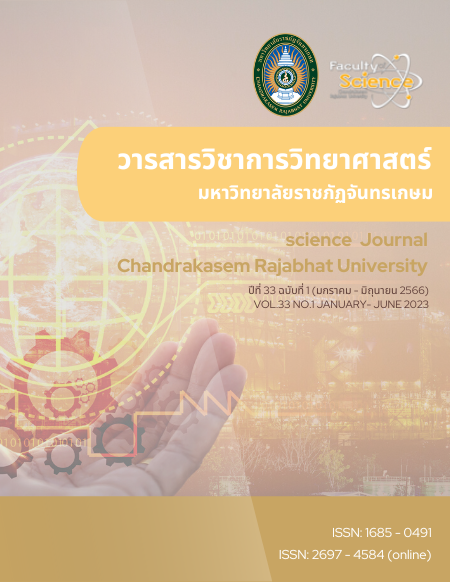การเปรียบเทียบผลของมุมเข่าขณะวางเท้าบนแท่นออกตัวด้วยระยะความยาวกระดูกหน้าและระยะถนัดที่มีต่อความสามารถในการสร้างแรงในนักกีฬาว่ายน้ำเยาวชน
คำสำคัญ:
ว่ายน้ำ, การออกตัวว่ายน้ำ, แรงสูงสุด, อัตราการพัฒนาแรงบทคัดย่อ
การวิจัยครั้งนี้มีวัตถุประสงค์เพื่อเพื่อเปรียบเทียบแรงสูงสุดและอัตราพัฒนาแรงสัมพัทธ์ระหว่างระยะถนัดและระยะความยาวกระดูกหน้าแข้งของการวางเท้าบนแท่นออกตัวในนักกีฬาว่ายน้ำเยาวชน กลุ่มตัวอย่าง นักกีฬาว่ายน้ำที่ฝึกซ้อมสำหรับการแข่งขันเพื่อความเป็นเลิศ สโมสรโรงเรียนสาธิตมหาวิทยาลัยศรีนครินทรวิโรฒ ปทุมวัน อายุ 14-18 ปี จำนวน 11 คน โดยการสุ่มแบบเฉพาะเจาะจง (Purposive Sampling) โดยที่สัปดาห์แรกดำเนินการวัดมุมเข่าของขาที่อยู่ด้านหลังของกลุ่มตัวอย่างที่อยู่ในท่าทางการออกตัวบนแท่นออกตัวโดยยืนแบบเท้านำเท้าตามวางบนที่ถีบด้านหลัง (Kick Start) ในระยะถนัด จากนั้นทดสอบไอโซเมตริกมิดไทด์พูลในมุมเข่าที่วัดมา สัปดาห์ต่อมา ดำเนินการวัดมุมเข่าของขาที่อยู่ด้านหลังของกลุ่มตัวอย่างที่อยู่ในท่าทางการออกตัวบนแท่นออกตัวโดยยืนแบบเท้านำเท้าตามวางบนที่ถีบด้านหลัง (Kick Start) ในระยะระยะความยาวกระดูกหน้าแข้ง จากนั้นทดสอบไอโซเมตริกมิดไทด์พูลในมุมเข่าที่วัดมา การวิเคราะห์ข้อมูลโดยใช้ค่าเฉลี่ย ส่วนเบี่ยงเบนมาตรฐาน เปรียบเทียบความแตกต่างเป็นรายคู่ โดยการทดสอบค่า “ที” และค่า “ซี” กำหนดนัยสำคัญทางสถิติที่ระดับ 0.05 ผลการวิจัยพบว่า แรงสูงสุดสัมพัทธ์ และอัตราการพัฒนาแรงสัมพัทธ์ ไม่แตกต่างกันอย่างมีนัยสำคัญทางสถิติที่ระดับ .05 เนื่องจากท่าทางการออกตัวบนแท่นออกตัวโดยยืนแบบเท้านำเท้าตามวางบนที่ถีบด้านหลัง (Kick Start) ของระยะห่างและมุมเข่าทั้ง 2 นั้น ไม่แตกต่างกัน แต่มีแนวโน้มว่าในระยะความยาวกระดูกหน้าแข้งนั้นสามารถสร้างแรงสูงสุดและอัตราการพัฒนาแรงสัมพัทธ์ได้ดีกว่า มากไปกว่านั้น ความแข็งแรงและพลังกล้ามเนื้อส่วนล่างยังคงเป็นสิ่งสำคัญที่ผู้ฝึกสอนและนักวิทยาศาสตร์การกีฬาควรให้ความสำคัญและผสมผสานอยู่ในแผนการฝึกซ้อมเสมอ
เอกสารอ้างอิง
Arellano, R., Pardillo, S., De La Fuente, B., & García, F. (2000, 25-30 June ). A system to improve the swimming start technique using force recording, timing and kinematic analyses. 18 International symposium on biomechanics in sports, Hong Kong, China.
Cicenia, A., Oster, C., & Mokha, M. (2019). Kick plate position and track start biomechanics in elite swimmers. Journal of Exercise and Nutrition, 2(3), 12.
Cossor, J., & Mason, B. (2001). Swim Start Performances at the Sydney 2000 Olympic Games. 19 International symposium on biomechanics in sports, San Francisco, USA.
Fédération Internationale De Natation. (2022). Swimming world records. https://www.fina.org/
Hannula, D. L., & Thornton, N. (2001). The swim coaching bible (Vol. 1). Human Kinetics, Inc.
Hay, J. C. (1993). The biomechanics of sports techniques (Vol. 4). Benjamin-Cummings publishing company, USA.
Honda, K., Sinclair, P., Mason, B., & Pease, D. (2010). A biomechanical comparison of elite swimmers start performance using the traditional track start and the new kick start. XIth International symposium on biomechanics and medicine in swimming, Oslo, Norwegian
Kiuchi, H., Nakashima, M., Cheng, K. B., & Hubbard, M. (2010). Modelling fluid forces in the dive start of competitive swimming. Journal of Biomechanical Science and Engineering, 5(4), 314-328. https://doi.org/10.1299/jbse.5.314
Miller, M., Allen, D., & Pein, R. (2003, June 21-23 ). A kinetic and kinematic comparison of the grab and track starts in swimming. IXth International symposium on biomechanics and medicine in swimming, Saint-Etienne.
Okuno, K., Ikuta, Y., Wakayoshi, K., Nomura, T., Takagi, H., Ito, S., Ogita, F., Ohgi, Y., Tachi, M., Miyashita, M. (2002). Stroke characteristics of world class male swimmers in freestyle events of the 9th FINA world swimming championships 2001 Fukuoka. IXth International symposium on biomechanics and medicine in swimming, University of Saint-Etienne, France.
Slawson, S. (2010). A novel monitoring system for the training of elite swimmers Loughborough University]. Loughborough University, United Kingdom.
Slawson, S., Chakravorti, N., Conway, P., Cossor, J., & West, A. (2012). The effect of knee angle on force production, in swimming starts, using the OSB11 block. Procedia Engineering, 34, 801-806. https://doi.org/10.1016/j.proeng.2012.04.137
Taber, C., Bellon, C., Abbott, H., & Bingham, G. E. (2016). Roles of maximal strength and rate of force development in maximizing muscular power. Strength & Conditioning Journal, 38(1), 71-78. https://doi.org/10.1519/SSC.0000000000000193
Tor, E., Pease, D., & Ball, K. (2014). Characteristics of an elite swimming start. XIIth International symposium for biomechanics and medicine in swimming, Canberra, Australian.
Tor, E., Pease, D. L., & Ball, K. A. (2015). Key parameters of the swimming start and their relationship to start performance. Journal of sports sciences, 33(13), 1313-1321. https://doi.org/10.1080/02640414.2014.990486
Vantorre, J., Chollet, D., & Seifert, L. (2014). Biomechanical analysis of the swim-start: A review. Journal of sports science & medicine, 13(2), 223-231.
Welcher, R. L., Hinrichs, R. N., & George, T. R. (2008). Front-or rear-weighted track start or grab start: which is the best for female swimmers? Sports biomechanics, 7(1), 100-113. https://doi.org/10.1080/14763140701683247
West, D. J., Owen, N. J., Cunningham, D. J., Cook, C. J., & Kilduff, L. P. (2011). Strength and power predictors of swimming starts in international sprint swimmers. The Journal of Strength & Conditioning Research, 25(4), 950-955. https://doi.org/10.1519/JSC.0b013e3181c8656f
ดาวน์โหลด
เผยแพร่แล้ว
รูปแบบการอ้างอิง
ฉบับ
ประเภทบทความ
สัญญาอนุญาต
ลิขสิทธิ์ (c) 2023 มหาวิทยาลัยราชภัฏจันทรเกษม

อนุญาตภายใต้เงื่อนไข Creative Commons Attribution-NonCommercial-NoDerivatives 4.0 International License.
บทความที่ได้รับการตีพิมพ์เป็นลิขสิทธิ์ของมหาวิทยาลัยราชภัฏจันทรเกษม
ข้อความที่ปรากฎในบทความแต่ละเรื่องในวารสารวิชาการเล่มนี้เป็นความคิดเห็นส่วนตัวของผู้เขียนแต่ละท่าน ไม่เกี่ยวข้องกับมหาวิทยาลัยราชภัฏจันทรเกษม และคณาจารย์ท่านอื่นในมหาวิทยาลัยแต่อย่างใด ความรับผิดชอบองค์ประกอบทั้งหมดของบทความแต่ละเรื่องเป็นของผู้เขียนแต่ละท่าน หากมีความผิดพลาดใดๆ ผู้เขียนแต่ละท่านจะรับผิดชอบบทความของตัวเองแต่เพียงผู้เดียว


 สำหรับผู้แต่ง (Author)
สำหรับผู้แต่ง (Author)





